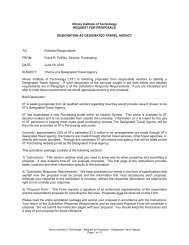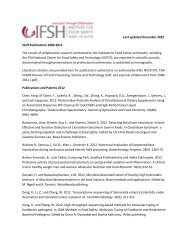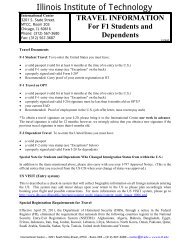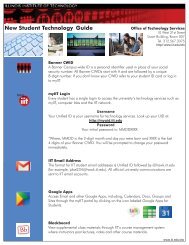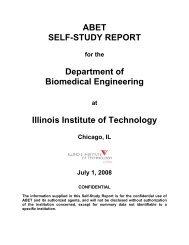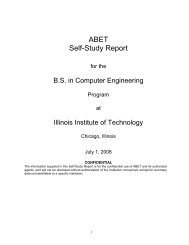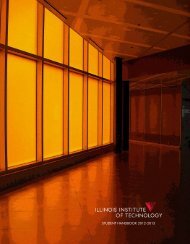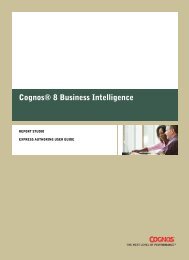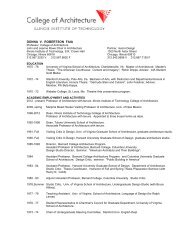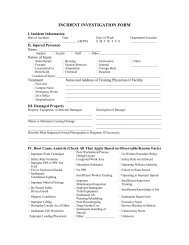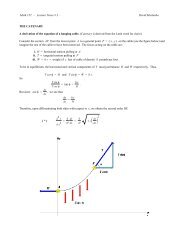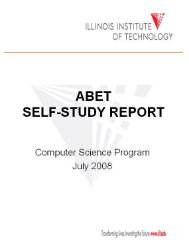Undergraduate Bulletin - Illinois Institute of Technology
Undergraduate Bulletin - Illinois Institute of Technology
Undergraduate Bulletin - Illinois Institute of Technology
Create successful ePaper yourself
Turn your PDF publications into a flip-book with our unique Google optimized e-Paper software.
Course Descriptions<br />
ARCH 447<br />
Architecture & Furniture<br />
Individually or in small groups, students will design and<br />
fabricate furniture as part <strong>of</strong> a collectively developed master<br />
plan. Students explore historic and contemporary furniture<br />
design, theory, materials, and fabrication techniques. Lectures<br />
and discussions will focus on the relationship between<br />
architecture and furniture in its 500-year history, the design<br />
process, fabrication technologies and techniques, drawing<br />
and modeling as a means <strong>of</strong> exploration, representation,<br />
presentation, and fabrication. Labs will allow students the<br />
opportunity to experience in a semester the traditional sequence<br />
<strong>of</strong> master plan, schematic design, design development,<br />
construction drawings, fabrication, and use.<br />
(1-2-3)<br />
ARCH 454<br />
Contemporary Chicago Architecture: Case Studies<br />
Contemporary architecture and urban design projects in<br />
Chicago present an invaluable opportunity to learn about<br />
some <strong>of</strong> the most advanced applications in practice today.<br />
By examining significant projects currently underway, this<br />
course will investigate project execution, design concepts and<br />
the various forces affecting projects’ definition and results.<br />
Close scrutiny <strong>of</strong> all the components and personnel will give<br />
a better understanding <strong>of</strong> the complex synergies, advanced<br />
technologies, and adept project teams necessary for successful<br />
innovative architecture and urban planning.<br />
(3-0-3)<br />
ARCH 456<br />
Topics in Modernism<br />
Historical and critical study <strong>of</strong> a significant topic in architecture<br />
and urban design tied to important building types,<br />
architects, architectural movements, historical periods, or<br />
theoretical trends <strong>of</strong> lasting significance in the twentieth<br />
century. Conducted as a seminar, this course analyzes texts,<br />
writings, and buildings as students prepare research papers,<br />
presentations, and other projects. Recent courses have<br />
examined modernism in post-World War II Europe and the<br />
United States and the history <strong>of</strong> the skyscraper from the<br />
Chicago school to the present.<br />
(3-0-3) (C)<br />
ARCH 457<br />
Architecture & Culture: Challenging the Global Vernacular<br />
This course investigates the link between architecture and the<br />
cultural, climatic, political, and socio-economic environment<br />
in which it is created. Taking a different cultural case study<br />
each week, it looks at the framework in which architecture is<br />
created and examines threads between traditional vernacular<br />
and modern forms <strong>of</strong> architecture. The course will embrace<br />
external influencing factors (global) as well as internal (local).<br />
As the building typology that has had perhaps the most<br />
influence on homogenizing global culture, the course studies<br />
tall buildings in their urban fabric. Ultimately, the course is<br />
concerned with the debate on Regionalist versus Globalist<br />
approaches to architecture. Students will develop critical<br />
writing and reading skills, research techniques, and effective<br />
argumentation. Open only to Architecture majors.<br />
(3-0-3)<br />
ARCH 460<br />
Integrated Building Delivery Practice/BIM<br />
Architecture has always been a complex interdisciplinary<br />
business, where the management <strong>of</strong> allied pr<strong>of</strong>essions and<br />
industry affiliates is critical to the success <strong>of</strong> any endeavor<br />
<strong>of</strong> significant scale. The introduction <strong>of</strong> BIM (Building<br />
Information Modeling) is an advance in project delivery tools<br />
which should be viewed as a multi-dimensional expansion<br />
<strong>of</strong> the mechanisms <strong>of</strong> management and accommodation <strong>of</strong><br />
an ever-broadening range <strong>of</strong> participants in the organization<br />
<strong>of</strong> a project, allowing the development <strong>of</strong> a new delivery<br />
protocol, IBPD (Integrated Building Project Delivery).<br />
BIM is currently recognized as consolidating the basis for a<br />
range <strong>of</strong> functions including drawing, modeling, document<br />
management, clash detection, interdisciplinary coordination,<br />
estimating, scheduling, constructability review, production<br />
modularization, fabrication protocols, and for the analysis<br />
<strong>of</strong> myriad physical and proscriptive demands such as energy<br />
consumption, daylighting, code compliance, egress, circulation,<br />
and operation scenarios. The breadth <strong>of</strong> information<br />
embedded in a BIM model will require the emergence <strong>of</strong><br />
facilitating pr<strong>of</strong>essionals to an extent previously unknown<br />
in the practice and the industry. This course explores the<br />
state <strong>of</strong> the pr<strong>of</strong>ession and the anticipated ramifications.<br />
<strong>Undergraduate</strong> students must be in their fifth year <strong>of</strong> study.<br />
Only for 5th year Architecture majors.<br />
(3-0-3)<br />
ARCH 461<br />
Entrepreneurship & Innovation in Architecture<br />
The course teaches future architects the practical aspects<br />
<strong>of</strong> entrepreneurial small business management, to develop<br />
a comprehensive opportunity assessment, and to develop<br />
the skills necessary to improve the odds <strong>of</strong> success. The<br />
course will consider strategies to leverage limited resources<br />
for maximum effect. The course will also cover small organization<br />
and group behavior, performance, leadership,<br />
and motivation in small business settings and will focus on<br />
the owner/manager as the principal success factor in the<br />
context <strong>of</strong> a small organization. Emphasis is placed on the<br />
circumstances and opportunities <strong>of</strong> the pr<strong>of</strong>essional practice<br />
<strong>of</strong> architecture: practice as pr<strong>of</strong>ession, process, organization,<br />
business, and evolving models <strong>of</strong> practice are covered. The<br />
course also provides a series <strong>of</strong> concepts, frameworks, and<br />
heuristics that enable the entrepreneur to anticipate and deal<br />
with the challenges that accompany growth <strong>of</strong> an existing<br />
business. Cases, exercises, lectures, and speakers are used<br />
to focus on choosing opportunities, allocating resources,<br />
motivating employees, and maintaining control while not<br />
stifling innovation. A key component <strong>of</strong> the course is how to<br />
sustain entrepreneurial thinking in mid-sized ventures as they<br />
continue to grow. <strong>Undergraduate</strong> students must be in their<br />
fifth year <strong>of</strong> study. Only for 5th year Architecture majors.<br />
(3-0-3)<br />
184



